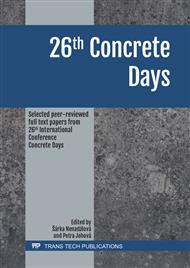[1]
Paulík, P. (2014). Bridges in Slovakia, JAGA, Bratislava, 271 s.
Google Scholar
[2]
Eurocode 2: Design of Concrete Structures, Part 1-1: General Rules and Rules for Buildings. CEN/CENELEC, TC250, April, (2004).
Google Scholar
[3]
Rombach, G., Latte, S. (2008). Shear resistance of bridge decks without shear reinforcement, In Proceedings of the International FIB Symposium.
DOI: 10.1201/9781439828410.ch86
Google Scholar
[4]
Vaz Rodrigues, R., Fernández Ruiz, M., Muttoni, A. (2008). Shear strength of R/C bridge cantilever slabs, In Engineering Structures.
DOI: 10.1016/j.engstruct.2008.04.017
Google Scholar
[5]
Reissen, K., Hegger, J. (2016). Experimental investigations on the effective width for shear, In Proceedings of the 8th International Conference on Bridge Maintenance, Safety and Management, IABMAS 2016, Foz do Iguaçu, Brazil.
DOI: 10.1201/9781315207681-361
Google Scholar
[6]
Natário, F., Fernández Ruiz, M., Muttoni, A. (2014). Shear strength of RC slabs under concentrated loads near clamped linear supports, In Engineering Structures.
DOI: 10.1016/j.engstruct.2014.06.036
Google Scholar
[7]
Rombach, G., Henze, L. (2017). Shear capacity of concrete slabs under concentrated loads close to support, In Proceedings of the 2017 PhD Symposium, Maastricht.
DOI: 10.1007/978-3-319-59471-2_80
Google Scholar
[8]
Vida, R., Halvonik, J. (2018). Tests of shear capacity of deck slabs under concentrated load, In Proceedings of the 12th fib International PhD Symposium in Civil Engineering, Prague.
Google Scholar
[9]
Vidaković, A., Halvonik, J. (2019). Shear resistance of clamped deck slabs assessed using design equations and FEM analysis, In 13th International Conference, Modern Building Materials, Structures and Techniques, Vilnius, Lithuania.
DOI: 10.3846/mbmst.2019.087
Google Scholar
[10]
Comité Euro-Internationale du Béton, CEB-FIP Model Code 1990, Comité Euro-Internationale du Béton, EPF Lausanne, Switzerland, (1993).
DOI: 10.1680/ceb-fipmc1990.35430
Google Scholar
[11]
Zsutty, T., Beam shear strength prediction by analysis of existing data. ACI Journal 65(11): 1968, pp.943-951.
Google Scholar
[12]
Regan, P. E. (1987), Shear resistance of members without shear reinforcement; proposal for CEB Model Code MC90, Polytechnic of Central London, London, U.K., 28 pp.
Google Scholar
[13]
König, G., Fischer, J. (1995). Model Uncertainties Concerning Design Equations for the Shear Capacity of Concrete Members without Shear Reinforcement, in CEB Bulletin 224, Model Uncertainties, July 1995, pp.49-100.
Google Scholar
[14]
Chauvel, D., Thonier, H., Coin, A., & Ile, N. (2007). Shear resistance of slabs not provided with shear reinforcement. CEN/TC 250/SC 02 N 726, France, 32 pp.
Google Scholar
[15]
Lantsoght, E. O. L., van der Veen, C., Walraven, J. (2013). Shear in one-way slabs under concentrated load close to support, ACI Structural Journal.
DOI: 10.14359/51684407
Google Scholar


